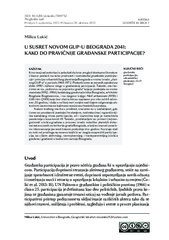U susret novom GUP-u Beograda 2041: kako do pravičnije građanske participacije?
Towards the New GUP Belgrade 2041: How to Achieve Fair Citizen Participation?
Чланак у часопису (Објављена верзија)
Метаподаци
Приказ свих података о документуАпстракт
Kroz ovaj rad autorka će pokušati da kroz pregled dostupne literature
čitaoce podseti na neke prednosti i nedostatke građanske participa cije i principe urbanističkog planiranja Beograda u vreme izrade „zlat nog GUP-a“ u periodu 1968-1972. Podsetićemo se mesnih zajednica u
doba SFRJ i njihove uloge u građanskoj paricipaciji. Takođe, osvrnu ćemo se na „radionicu za popravku grada“ koja je postojala za vreme
mandata (1982.-1986.) tadašnjeg gradonačelnika Beograda, arhitekte
Bogdana Bogdanovića, i na njegove knjige Mali urbanizam (1958) i
Glib i krv (2001) koje bez obzira što su napisane pre više od 64 odno sno 20 godina, i dalje u velikoj meri svojim sadržajem odgovaraju ak tuelnim izazovima sa kojima se suočava urbanistička praksa.
Nakon kratkog osvrta u prošlost, vraćamo se u sadašnjost, gde
ćemo se pozabaviti postojećim stanjem, nedostacima i ograničenji ma sadašnjeg nivoa participacije, ali i izazovima koje je nametnula
pandemija virusa kovid-19. Takođe, predstavljeni... su primeri (ne)mo gućnosti učešća građana u procesu izrade nekoliko planskih doku menata vezanih za teritoriju grada Beograda, a koji su izazvali poseb no interesovanje javnosti tokom poslednje dve godine. Na kraju dati
su neki od predloga na osnovu kojih bi se mogla unaprediti participa cija, sa ciljem aktivnijeg, ravnopravnijeg i transparentnijeg učešća
građana i građanki u budućem razvoju Beograda.
Through this paper, the author will try to remind the readers of some advantages, but
also disadvantages of civic participation and the principles of urban planning in Bel grade during the preparation of the “golden GUP” in the period 1968-1972. We will
recall the local communities in the SFRY era and their role in civic participation. We
will look back on the “workshop for city repair” that existed during the mandate
(1982-1986) of the then Belgrade’s Mayor, architect Bogdan Bogdanović, but also to
his books Mali urbanizam 1958 (engl. Small urbanism) and Glib i krv 2001 (engl. Mud
and blood), which, regardless of the fact that they were written more than 20 and 64
years ago, still correspond to a large extent in their content to the current challenges
faced by the urban planning profession.
After a brief look into the past, we return to the present, where we will address the
current state, shortcomings, and limitations of the current level of civic participation,
...as well as the challenges imposed by the Covid 19 virus pandemic. Also, examples of
the (im)possibility of citizens’ participation in the process of drafting several planning
documents related to the territory of the city of Belgrade, which have aroused special
public interest during the last two years, were presented. At the end, some proposals
were given on the basis of which civic participation could be improved, with the aim
of more active, equal and transparent participation in the future development of
Belgrade.
Кључне речи:
građanska participacija / urbanističko planiranje / GUP / BeogradИзвор:
Kritika: časopis za filozofiju i teoriju društva, 2022, 3, 2, 333-356Издавач:
- Beograd : Institut za filozofiju i društvenu teoriju
URI
https://kritika.instifdt.bg.ac.rs/index.php/kc/article/view/107/203http://rifdt.instifdt.bg.ac.rs/123456789/2756
Институција/група
IFDTTY - JOUR AU - Lukić, Milica PY - 2022 UR - https://kritika.instifdt.bg.ac.rs/index.php/kc/article/view/107/203 UR - http://rifdt.instifdt.bg.ac.rs/123456789/2756 AB - Kroz ovaj rad autorka će pokušati da kroz pregled dostupne literature čitaoce podseti na neke prednosti i nedostatke građanske participa cije i principe urbanističkog planiranja Beograda u vreme izrade „zlat nog GUP-a“ u periodu 1968-1972. Podsetićemo se mesnih zajednica u doba SFRJ i njihove uloge u građanskoj paricipaciji. Takođe, osvrnu ćemo se na „radionicu za popravku grada“ koja je postojala za vreme mandata (1982.-1986.) tadašnjeg gradonačelnika Beograda, arhitekte Bogdana Bogdanovića, i na njegove knjige Mali urbanizam (1958) i Glib i krv (2001) koje bez obzira što su napisane pre više od 64 odno sno 20 godina, i dalje u velikoj meri svojim sadržajem odgovaraju ak tuelnim izazovima sa kojima se suočava urbanistička praksa. Nakon kratkog osvrta u prošlost, vraćamo se u sadašnjost, gde ćemo se pozabaviti postojećim stanjem, nedostacima i ograničenji ma sadašnjeg nivoa participacije, ali i izazovima koje je nametnula pandemija virusa kovid-19. Takođe, predstavljeni su primeri (ne)mo gućnosti učešća građana u procesu izrade nekoliko planskih doku menata vezanih za teritoriju grada Beograda, a koji su izazvali poseb no interesovanje javnosti tokom poslednje dve godine. Na kraju dati su neki od predloga na osnovu kojih bi se mogla unaprediti participa cija, sa ciljem aktivnijeg, ravnopravnijeg i transparentnijeg učešća građana i građanki u budućem razvoju Beograda. AB - Through this paper, the author will try to remind the readers of some advantages, but also disadvantages of civic participation and the principles of urban planning in Bel grade during the preparation of the “golden GUP” in the period 1968-1972. We will recall the local communities in the SFRY era and their role in civic participation. We will look back on the “workshop for city repair” that existed during the mandate (1982-1986) of the then Belgrade’s Mayor, architect Bogdan Bogdanović, but also to his books Mali urbanizam 1958 (engl. Small urbanism) and Glib i krv 2001 (engl. Mud and blood), which, regardless of the fact that they were written more than 20 and 64 years ago, still correspond to a large extent in their content to the current challenges faced by the urban planning profession. After a brief look into the past, we return to the present, where we will address the current state, shortcomings, and limitations of the current level of civic participation, as well as the challenges imposed by the Covid 19 virus pandemic. Also, examples of the (im)possibility of citizens’ participation in the process of drafting several planning documents related to the territory of the city of Belgrade, which have aroused special public interest during the last two years, were presented. At the end, some proposals were given on the basis of which civic participation could be improved, with the aim of more active, equal and transparent participation in the future development of Belgrade. PB - Beograd : Institut za filozofiju i društvenu teoriju T2 - Kritika: časopis za filozofiju i teoriju društva T1 - U susret novom GUP-u Beograda 2041: kako do pravičnije građanske participacije? T1 - Towards the New GUP Belgrade 2041: How to Achieve Fair Citizen Participation? IS - 2 VL - 3 SP - 333 EP - 356 DO - 10.5281/zenodo.7369712 ER -
@article{
author = "Lukić, Milica",
year = "2022",
abstract = "Kroz ovaj rad autorka će pokušati da kroz pregled dostupne literature
čitaoce podseti na neke prednosti i nedostatke građanske participa cije i principe urbanističkog planiranja Beograda u vreme izrade „zlat nog GUP-a“ u periodu 1968-1972. Podsetićemo se mesnih zajednica u
doba SFRJ i njihove uloge u građanskoj paricipaciji. Takođe, osvrnu ćemo se na „radionicu za popravku grada“ koja je postojala za vreme
mandata (1982.-1986.) tadašnjeg gradonačelnika Beograda, arhitekte
Bogdana Bogdanovića, i na njegove knjige Mali urbanizam (1958) i
Glib i krv (2001) koje bez obzira što su napisane pre više od 64 odno sno 20 godina, i dalje u velikoj meri svojim sadržajem odgovaraju ak tuelnim izazovima sa kojima se suočava urbanistička praksa.
Nakon kratkog osvrta u prošlost, vraćamo se u sadašnjost, gde
ćemo se pozabaviti postojećim stanjem, nedostacima i ograničenji ma sadašnjeg nivoa participacije, ali i izazovima koje je nametnula
pandemija virusa kovid-19. Takođe, predstavljeni su primeri (ne)mo gućnosti učešća građana u procesu izrade nekoliko planskih doku menata vezanih za teritoriju grada Beograda, a koji su izazvali poseb no interesovanje javnosti tokom poslednje dve godine. Na kraju dati
su neki od predloga na osnovu kojih bi se mogla unaprediti participa cija, sa ciljem aktivnijeg, ravnopravnijeg i transparentnijeg učešća
građana i građanki u budućem razvoju Beograda., Through this paper, the author will try to remind the readers of some advantages, but
also disadvantages of civic participation and the principles of urban planning in Bel grade during the preparation of the “golden GUP” in the period 1968-1972. We will
recall the local communities in the SFRY era and their role in civic participation. We
will look back on the “workshop for city repair” that existed during the mandate
(1982-1986) of the then Belgrade’s Mayor, architect Bogdan Bogdanović, but also to
his books Mali urbanizam 1958 (engl. Small urbanism) and Glib i krv 2001 (engl. Mud
and blood), which, regardless of the fact that they were written more than 20 and 64
years ago, still correspond to a large extent in their content to the current challenges
faced by the urban planning profession.
After a brief look into the past, we return to the present, where we will address the
current state, shortcomings, and limitations of the current level of civic participation,
as well as the challenges imposed by the Covid 19 virus pandemic. Also, examples of
the (im)possibility of citizens’ participation in the process of drafting several planning
documents related to the territory of the city of Belgrade, which have aroused special
public interest during the last two years, were presented. At the end, some proposals
were given on the basis of which civic participation could be improved, with the aim
of more active, equal and transparent participation in the future development of
Belgrade.",
publisher = "Beograd : Institut za filozofiju i društvenu teoriju",
journal = "Kritika: časopis za filozofiju i teoriju društva",
title = "U susret novom GUP-u Beograda 2041: kako do pravičnije građanske participacije?, Towards the New GUP Belgrade 2041: How to Achieve Fair Citizen Participation?",
number = "2",
volume = "3",
pages = "333-356",
doi = "10.5281/zenodo.7369712"
}
Lukić, M.. (2022). U susret novom GUP-u Beograda 2041: kako do pravičnije građanske participacije?. in Kritika: časopis za filozofiju i teoriju društva Beograd : Institut za filozofiju i društvenu teoriju., 3(2), 333-356. https://doi.org/10.5281/zenodo.7369712
Lukić M. U susret novom GUP-u Beograda 2041: kako do pravičnije građanske participacije?. in Kritika: časopis za filozofiju i teoriju društva. 2022;3(2):333-356. doi:10.5281/zenodo.7369712 .
Lukić, Milica, "U susret novom GUP-u Beograda 2041: kako do pravičnije građanske participacije?" in Kritika: časopis za filozofiju i teoriju društva, 3, no. 2 (2022):333-356, https://doi.org/10.5281/zenodo.7369712 . .


